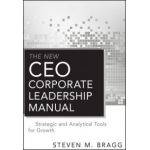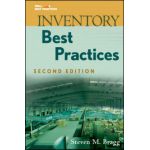New CEO Corporate Leadership Manual

Preț: 510,00 lei
Disponibilitate: la comandă
Autor: Steven Bragg
ISBN: 9780470912874
Editura: Wiley
Anul publicării: 2011
Pagini: 360
DESCRIERE
The ultimate instruction manual for every new CEO
The New CEO Corporate Leadership Manual is essential reading for every CEO needing a blueprint for the role of CEO, including an overview of organizational structure, corporate strategy, management systems and finance. Along with considerable information about the financial systems needed for a modern corporation, with particular emphasis on funds management, going public, and dealing with investors, this important book explains how to select acquisition targets, price them appropriately, and successfully integrate them, as well as how to turn around a failing enterprise.
Gives new CEOs a hard, quantitative view of the systems and techniques needed to run a company
Discusses the CEO's place in the corporation
Explores information technology strategy, tax strategy, outsourcing strategy and more
Filled with pragmatic insights, proactive strategies, and best practices, The New CEO Corporate Leadership Manual is destined to become the desktop companion you employ to be successful in your new position.
Preface.
Chapter 1 New CEO Activities.
Immediate Priorities.
Measure the Business.
Get to Know the Company.
Develop a Strategy.
Create a Budget and Related Systems.
Review the Management Team.
Review Risks.
Review Costs.
Summary.
Part I Strategy Development.
Chapter 2 General Corporate Strategy.
Overview of General Corporate Strategy.
Building a Strategy: General Concepts.
Building a Strategy: Product Differentiation.
Building a Strategy: Low Cost.
Building a Strategy: Focus on a Niche.
Building a Strategy: Impact of the Internet.
Building a Strategy: Additional Comments.
Strategy Testing.
Summary.
Chapter 3 Financial Strategy.
Cash.
Investments.
Working Capital.
Inventory Reduction Decision.
Fixed Asset Lease Versus Buy Decisions.
Payables.
Debt.
Equity.
Product Elimination Decisions.
Step Cost Reductions.
Temporary Labor Decisions.
Divestiture Decisions.
Summary.
Chapter 4 Tax Strategy.
Accumulated Earnings Tax.
Cash Method of Accounting.
Inventory Valuation.
Mergers and Acquisitions.
Net Operating Loss Carryforwards.
Nexus.
S Corporation.
Sales and Use Taxes.
Transfer Pricing.
Unemployment Taxes.
Summary.
Chapter 5 Information Technology Strategy.
Reasons for Devising an Information Technology Strategy.
Developing the Information Technology Strategy
Technical Strategies.
Specific Applications.
Summary.
Chapter 6 Outsourcing Strategy.
Overview of Outsourcing.
Outsourcing Risks.
Initiating Outsourcing.
Companies that Take Over Outsourced Functions.
Summary.
Part II The Budget.
Chapter 7 Budgeting Process.
System of Interlocking Budgets.
A Sample Budget.
Flex Budget.
Budgetary Control Systems.
Summary.
Chapter 8 Capital Budgeting.
Hurdle Rate.
Payback Period.
Net Present Value.
Internal Rate of Return.
Throughput-Based Capital Budgeting.
Problems with the Capital Budget Approval Process.
Cash Flow Modeling Issues.
Funding Decisions for Research and Development Projects.
Post-Completion Project Analysis.
Summary.
Part III Risk Management.
Chapter 9 Risk Management: General Concepts.
Risk Management Policies.
Risk Management Planning.
Manager of Risk Management.
Risk Management Procedures.
Types of Business Insurance.
Types of Insurance Companies.
Evaluating the Health of an Insurance Carrier.
Annual Risk Management Report.
Summary.
Chapter 10 Risk Management: Foreign Exchange.
Foreign Exchange Quote Terminology.
Nature of Foreign Exchange Risk.
Data Collection for Foreign Exchange Risk Management.
Foreign Exchange Hedging Strategies.
Summary.
Part IV Financial Analysis.
Chapter 11 Performance Measurements.
Asset Utilization Measurements.
Operating Performance Measurements.
Cash Flow Measurements.
Liquidity Measurements.
Solvency Measurements.
Return on Investment Measurements.
Market Performance Measurements.
Summary.
Chapter 12 Cost Reduction Analysis.
Types of Reports Used for Cost Reduction Analysis.
Spend Analysis Overview.
Spend Database.
Supplier Consolidation Analysis.
Parts Consolidation Analysis.
Maintenance, Repair, and Operations Item Analysis.
Spend Compliance.
Spend Analysis Reports.
Workforce Reduction Analysis.
Workforce Reduction Issues.
Workforce Reduction Alternatives.
5S Analysis.
Error Quantification.
Fixed Cost Analysis.
Ishikawa Diagrams.
Value Stream Mapping.
Waste Analysis.
Summary.
Chapter 13 Mergers and Acquisitions.
Evaluating Acquisition Targets.
Complexity Analysis.
Valuing an Acquisition Target.
Types of Acquisitions.
Summary.
Part V The Public company.
Chapter 14 Initial Public Offering.
Reasons to Go Public.
Reasons Not to Go Public.
Cost of an IPO.
Preparing for the IPO.
Finding an Underwriter.
Registering for and Completing the IPO.
Alternatives for Selling Securities.
Trading on an Exchange.
Overview of the NASDAQ.
New York Stock Exchange.
Comparing the Stock Exchanges.
Over-the-Counter Stocks.
Summary.
Chapter 15 Investment Community.
Analyst’s Perspective.
Finding the Right Analyst.
Sell Side: Analysts.
Negative Analyst Report.
Sell Side: Brokers.
Sell Side: Investment Bankers.
Sell Side: Investor Relations Specialists.
Buy Side: Types of Investors.
Buy Side: Institutional Investors.
Buy Side: Individual Investors.
Buy Side: Presentations to Investors.
Summary.
Chapter 16 Public Company Activities.
Investor Conference Call.
The Road Show.
Concept of Guidance.
Form of Guidance Issued.
Frequency and Timing of Guidance.
Aggressiveness of Guidance.
How Short Sellers Operate.
How to Handle Short Sellers.
Measuring Short Seller Activity.
Summary.
Chapter 17 Taking a Company Private.
Going Private Transaction.
Rule 13e-3.
300 Shareholder Limit.
Form 15.
Summary.
Appendix New CEO Checklist.
About the Author.
Index.
STEVEN M. BRAGG,?CPA, has been the chief financial officer or controller of four companies, as well as a consulting manager at Ernst & Young and auditor at Deloitte. He is the author of over thirty books primarily targeted toward corporate financial leaders (controllers, treasurers, and CFOs) and their needs. Bragg received a master's degree in finance from Bentley College, an MBA from Babson College, and a bachelor's degree in economics from the University of Maine.
The New CEO Corporate Leadership Manual is essential reading for every CEO needing a blueprint for the role of CEO, including an overview of organizational structure, corporate strategy, management systems and finance. Along with considerable information about the financial systems needed for a modern corporation, with particular emphasis on funds management, going public, and dealing with investors, this important book explains how to select acquisition targets, price them appropriately, and successfully integrate them, as well as how to turn around a failing enterprise.
Gives new CEOs a hard, quantitative view of the systems and techniques needed to run a company
Discusses the CEO's place in the corporation
Explores information technology strategy, tax strategy, outsourcing strategy and more
Filled with pragmatic insights, proactive strategies, and best practices, The New CEO Corporate Leadership Manual is destined to become the desktop companion you employ to be successful in your new position.
Preface.
Chapter 1 New CEO Activities.
Immediate Priorities.
Measure the Business.
Get to Know the Company.
Develop a Strategy.
Create a Budget and Related Systems.
Review the Management Team.
Review Risks.
Review Costs.
Summary.
Part I Strategy Development.
Chapter 2 General Corporate Strategy.
Overview of General Corporate Strategy.
Building a Strategy: General Concepts.
Building a Strategy: Product Differentiation.
Building a Strategy: Low Cost.
Building a Strategy: Focus on a Niche.
Building a Strategy: Impact of the Internet.
Building a Strategy: Additional Comments.
Strategy Testing.
Summary.
Chapter 3 Financial Strategy.
Cash.
Investments.
Working Capital.
Inventory Reduction Decision.
Fixed Asset Lease Versus Buy Decisions.
Payables.
Debt.
Equity.
Product Elimination Decisions.
Step Cost Reductions.
Temporary Labor Decisions.
Divestiture Decisions.
Summary.
Chapter 4 Tax Strategy.
Accumulated Earnings Tax.
Cash Method of Accounting.
Inventory Valuation.
Mergers and Acquisitions.
Net Operating Loss Carryforwards.
Nexus.
S Corporation.
Sales and Use Taxes.
Transfer Pricing.
Unemployment Taxes.
Summary.
Chapter 5 Information Technology Strategy.
Reasons for Devising an Information Technology Strategy.
Developing the Information Technology Strategy
Technical Strategies.
Specific Applications.
Summary.
Chapter 6 Outsourcing Strategy.
Overview of Outsourcing.
Outsourcing Risks.
Initiating Outsourcing.
Companies that Take Over Outsourced Functions.
Summary.
Part II The Budget.
Chapter 7 Budgeting Process.
System of Interlocking Budgets.
A Sample Budget.
Flex Budget.
Budgetary Control Systems.
Summary.
Chapter 8 Capital Budgeting.
Hurdle Rate.
Payback Period.
Net Present Value.
Internal Rate of Return.
Throughput-Based Capital Budgeting.
Problems with the Capital Budget Approval Process.
Cash Flow Modeling Issues.
Funding Decisions for Research and Development Projects.
Post-Completion Project Analysis.
Summary.
Part III Risk Management.
Chapter 9 Risk Management: General Concepts.
Risk Management Policies.
Risk Management Planning.
Manager of Risk Management.
Risk Management Procedures.
Types of Business Insurance.
Types of Insurance Companies.
Evaluating the Health of an Insurance Carrier.
Annual Risk Management Report.
Summary.
Chapter 10 Risk Management: Foreign Exchange.
Foreign Exchange Quote Terminology.
Nature of Foreign Exchange Risk.
Data Collection for Foreign Exchange Risk Management.
Foreign Exchange Hedging Strategies.
Summary.
Part IV Financial Analysis.
Chapter 11 Performance Measurements.
Asset Utilization Measurements.
Operating Performance Measurements.
Cash Flow Measurements.
Liquidity Measurements.
Solvency Measurements.
Return on Investment Measurements.
Market Performance Measurements.
Summary.
Chapter 12 Cost Reduction Analysis.
Types of Reports Used for Cost Reduction Analysis.
Spend Analysis Overview.
Spend Database.
Supplier Consolidation Analysis.
Parts Consolidation Analysis.
Maintenance, Repair, and Operations Item Analysis.
Spend Compliance.
Spend Analysis Reports.
Workforce Reduction Analysis.
Workforce Reduction Issues.
Workforce Reduction Alternatives.
5S Analysis.
Error Quantification.
Fixed Cost Analysis.
Ishikawa Diagrams.
Value Stream Mapping.
Waste Analysis.
Summary.
Chapter 13 Mergers and Acquisitions.
Evaluating Acquisition Targets.
Complexity Analysis.
Valuing an Acquisition Target.
Types of Acquisitions.
Summary.
Part V The Public company.
Chapter 14 Initial Public Offering.
Reasons to Go Public.
Reasons Not to Go Public.
Cost of an IPO.
Preparing for the IPO.
Finding an Underwriter.
Registering for and Completing the IPO.
Alternatives for Selling Securities.
Trading on an Exchange.
Overview of the NASDAQ.
New York Stock Exchange.
Comparing the Stock Exchanges.
Over-the-Counter Stocks.
Summary.
Chapter 15 Investment Community.
Analyst’s Perspective.
Finding the Right Analyst.
Sell Side: Analysts.
Negative Analyst Report.
Sell Side: Brokers.
Sell Side: Investment Bankers.
Sell Side: Investor Relations Specialists.
Buy Side: Types of Investors.
Buy Side: Institutional Investors.
Buy Side: Individual Investors.
Buy Side: Presentations to Investors.
Summary.
Chapter 16 Public Company Activities.
Investor Conference Call.
The Road Show.
Concept of Guidance.
Form of Guidance Issued.
Frequency and Timing of Guidance.
Aggressiveness of Guidance.
How Short Sellers Operate.
How to Handle Short Sellers.
Measuring Short Seller Activity.
Summary.
Chapter 17 Taking a Company Private.
Going Private Transaction.
Rule 13e-3.
300 Shareholder Limit.
Form 15.
Summary.
Appendix New CEO Checklist.
About the Author.
Index.
STEVEN M. BRAGG,?CPA, has been the chief financial officer or controller of four companies, as well as a consulting manager at Ernst & Young and auditor at Deloitte. He is the author of over thirty books primarily targeted toward corporate financial leaders (controllers, treasurers, and CFOs) and their needs. Bragg received a master's degree in finance from Bentley College, an MBA from Babson College, and a bachelor's degree in economics from the University of Maine.
Accesul clienţilor
-Top 10
-Cărţi noi
-- 344,25 leiPRP: 382,50 lei
- 1505,52 leiPRP: 1672,80 lei
- 546,21 leiPRP: 606,90 lei
Promoţii
-- 280,00 leiPRP: 350,00 lei
- 29,25 leiPRP: 45,00 lei
- 29,25 leiPRP: 45,00 lei










RECENZII